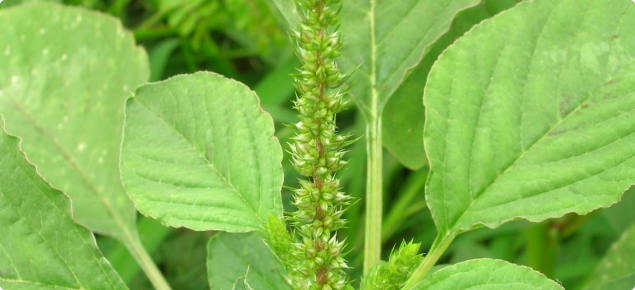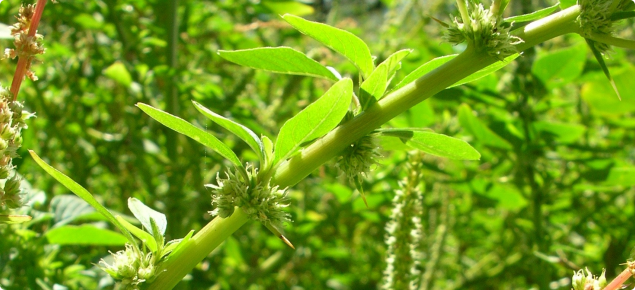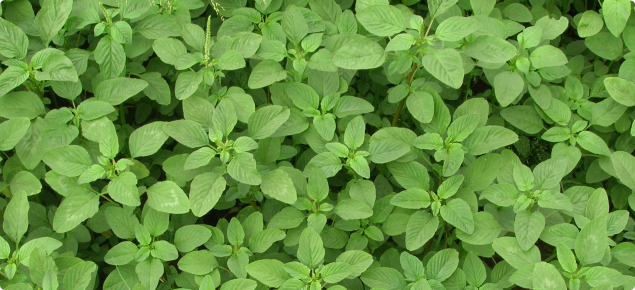Form: herbaceous — annual
Status: present in WA
Needle burr (Amaranthus spinosus) is a summer-growing annual that originated in northern or central America. It is now widespread through tropical and subtropical countries and regions, and is recognised as a weed of many crops. It is increasingly being found in temperate regions.
In the Eastern States, needle burr is naturalised along the north and east coasts of Australia, including the Northern Territory, the east coast of Queensland, and the northern and central coasts of New South Wales. In these areas it is a relatively widespread weed of stockyards, wasteland, roadsides and occasionally, pastures, but it is not considered a weed of great significance. It was unknown in Western Australia until collected near Northampton in late April 2005.
Appearance
One of its most distinctive features is the presence of large numbers of pairs of stiff spines, around one centimetre long, each pair arising from the base of a leaf. As with many other thorny or spiny weeds, the sharp spines of needle burr deter grazing animals, and make the plant painful to handle.
Stems: Needle burr is a robust, branched, upright plant that grows to 50-100 centimetres, occasionally reaching 1.2 metres or more if growing amongst tall plants such as maize. The stem is stiff when mature and is ribbed lengthwise.
Leaves: The dull green leaves are shaped like a spearhead, and are borne on long slender stalks. The leaf blade is up to four centimetres wide and eight centimetres long, and has large numbers of veins running off the midrib. The blade sometimes has a pale patch or v-shaped mark on its upper surface, although leaves of plants collected from Northampton had a large purple blotch on the upper surface. The characteristic pairs of spines arise on the stem where each leaf is attached.
Flowers: Flowering plants bear large numbers of small papery greenish-white flowers crowded together in a long tail-like spike, which extends beyond the leafy part of the stem. Shorter spikes and clusters of flowers are found lower down the stem. The chaffy bracts that surround each flower are tipped with a short spine.
Fruits: The fruit is a small capsule one to two millimetres across, each containing a single seed, and surrounded by pale papery bracts. Despite its common name it does not produce a burr.
Seeds: Needle burr seeds are small (0.7–1 millimetres), shiny black or dark brown when ripe, and shaped like a pinhead with a small notch at one side. A large plant can produce over 200 000 seeds in a season.
Agriculture and economic impact
A weed of many grain and horticultural crops. This weed has the potential to outcompete native vegetation and induce the loss of biodiversity,altering ecosystems and displacing native grasslands.
Declared pest category
The Western Australian Organism List (WAOL) contains information on the area(s) in which this pest is declared and the control and keeping categories to which it has been assigned in Western Australia (WA). Search for needle burr in the WAOL using the scientific naame Amaranthus spinosus.
Requirements for land owners/occupiers and other persons
Requirements for land owners/occupiers and other persons if this pest is found can be sourced through the declared plant requirements link.
Search > detect > report
| MyPestGuide™ Reporter | Pest and Disease Information Service (PaDIS) |
Control method
Control methods for this declared plant can be found through the needle burr control link.



